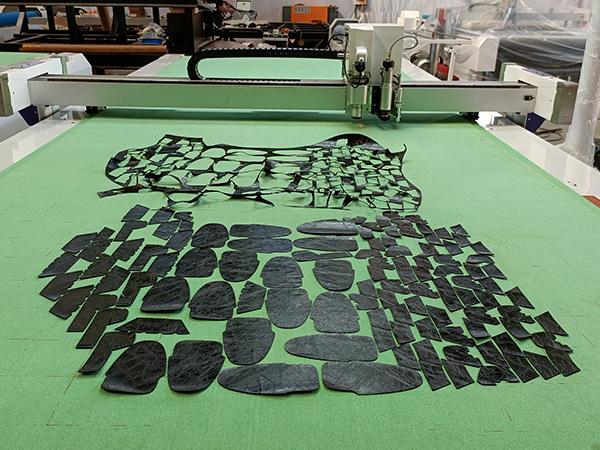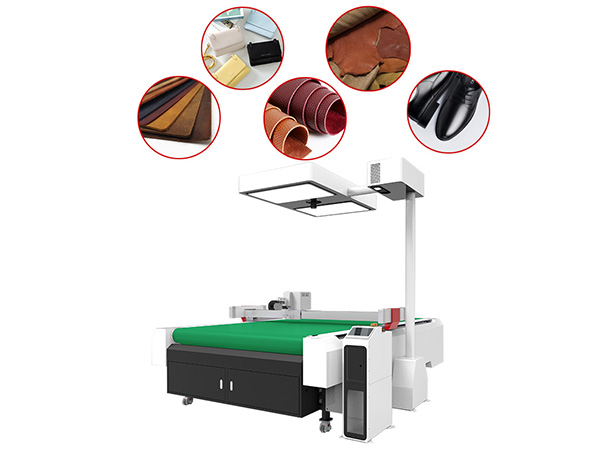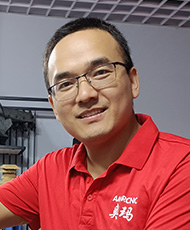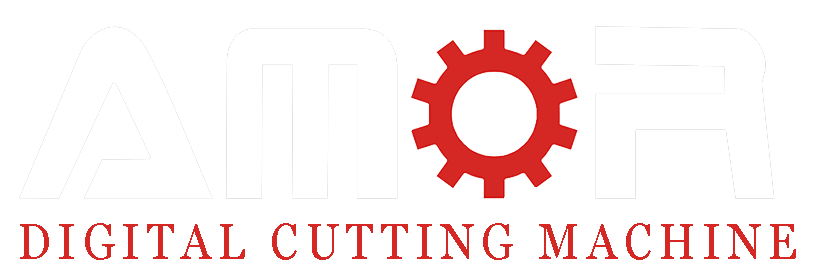Genuine leather is widely used in leather sofas, car interiors, bags and shoemaking industries. Genuine leather is actually a general term. Cowhide, pigskin, horsehide, and donkey skin can all be used as genuine leather raw materials. Genuine leather has natural pores and skin texture. It feels plump, soft and elastic, so genuine leather is also loved by people.
Genuine leather industry has undergone significant transformations in terms of cutting technologies. From manual labor-intensive techniques to advanced CNC Oscillating Knife Cutting Machines, each stage marks a substantial improvement in efficiency, precision, and quality control.
Challenges in Manual Leather Cutting
Manual leather cutting has been a traditional method used for generations in the leather industry. While the craftsmanship involved can produce remarkable products, there are significant challenges that businesses face, particularly concerning efficiency, waste, and cost.
Efficiency
Time-Consuming Process
Manual cutting is labor-intensive and time-consuming, especially for complex designs. This lack of speed can be a major bottleneck in the production line, affecting the overall throughput of the business.
Skill-Dependent
The efficiency of manual cutting is highly dependent on the skill of the craftsman. Inconsistent skill levels across workers can lead to variable production rates, further compromising efficiency.
Waste
Material Inconsistency
Human error can lead to imprecise cuts, resulting in material wastage. In a domain where raw materials like quality leather come at a premium, wastage directly impacts profitability.
Lack of Material Utilization
Manual cutting often lacks the advanced nesting algorithms found in modern CNC machines. This leads to sub-optimal layout of patterns, further contributing to material waste.
Cost
Labor Costs
Skilled labor is expensive. The manual leather cutting process requires craftsmen who are both skilled and experienced, and their wages contribute significantly to operational costs.
Inconsistency Costs
The inconsistency in cuts and the potential for waste translate into hidden costs, affecting the bottom line by requiring more material to produce the same number of finished goods.
While manual leather cutting has its own unique merits, including craftsmanship and the human touch, the challenges in efficiency, waste, and cost make it less suitable for businesses aiming for high-volume, consistent, and cost-effective production. Switching to advanced cutting solutions like CNC Oscillating Knife Cutting Machines can dramatically improve these aspects, offering a more sustainable and profitable approach for modern leather businesses.

Challenges in Laser Cutting of Leather
Laser cutting technology has been integrated into various industries, including the leather sector, for its high precision and ability to handle intricate designs. However, there are several inherent challenges in utilizing laser cutting specifically for leather materials.
Heat Damage
Edge Burnt or Discolored
Laser cutting involves the use of high-energy beams to cut through material. The heat generated can cause the edges of the leather to become burnt or discolored, impacting the overall aesthetic and quality of the finished product.
Thermal Deformation
The high temperature involved in the laser cutting process can potentially alter the leather’s structural integrity, causing it to deform or shrink.
Energy Costs
High Consumption
Lasers are energy-intensive machines. Operating a laser cutting machine involves substantial electrical consumption, adding to the operational costs.
Cooling Systems
Many laser systems require additional cooling mechanisms to operate efficiently, which adds another layer of complexity and cost to the operation.
Material Constraints
Limited Thickness Handling
Lasers have limitations when it comes to the thickness of the leather that can be effectively cut, which might not be suitable for all applications.
Restricted Material Types
Certain types of treated or coated leather may react adversely to laser cutting, limiting the range of materials that can be used.
While laser cutting offers a high degree of precision, it comes with its own set of challenges, particularly in the context of leather cutting. Issues like heat-induced damage, high energy costs, and material constraints can make laser cutting less than ideal for some leather applications. Companies looking for a more versatile and efficient cutting solution may benefit from considering alternatives like CNC Oscillating Knife Cutting Machines, which provide precision without the associated challenges of laser cutting.

Advantages of Oscillating Knife Cutting Machines in Leather Cutting
Efficiency
High-Speed Operation
These machines can cut at remarkable speeds without sacrificing precision, significantly improving production throughput.
Consistency
CNC control ensures that every cut is as precise as the last, reducing errors and waste, thereby enhancing the overall efficiency of the production process.
Versatility
Oscillating knife cutters can handle a wide range of leather types and thicknesses, making them versatile additions to any production line.
Eco-Friendliness
Minimal Waste
Advanced nesting algorithms optimize material usage, significantly reducing waste and making the most out of every leather sheet.
No Heat Damage
Unlike laser cutters, oscillating knife machines don’t produce heat, thus avoiding thermal damage to the leather and reducing energy consumption.
Low Energy Requirements
Compared to laser systems, these machines require less energy to operate, contributing to a lower carbon footprint.
Intelligent Features
Automated Workflow
These machines can be integrated into an automated production line, reducing the need for manual intervention.
Advanced Software
State-of-the-art software allows for intricate designs to be cut with pinpoint accuracy, catering to customized orders and complex patterns.
Real-time Monitoring
Many advanced models come equipped with real-time monitoring capabilities, allowing for immediate adjustments and ensuring optimal performance.

AMOR Genuine Leather Cutting Solution
AMOR CNC has been focusing on the research and development of intelligent cutting technology for flexible materials, providing professional overall solutions for the transformation and upgrading of traditional manufacturing enterprises, creating an overall solution for leather intelligent cutting machines, helping to complete the digitalization process of leather cutting, and truly replacing technology with machines. Manual cutting and effective integration of man and machine improve production efficiency and reduce production costs.
The speed of the leather intelligent cutting machine is 4-6 times that of traditional manual cutting, achieving fast cutting, fast discharging, and fast production, especially for small orders and many styles. It adopts computer control, and the safety distance of the model can be accurately 0.1-1mm, and continuous cutting, which avoids damage to the leather by laser cutting, and also avoids manual errors in manual cutting, making the material discharging more accurate and ensuring product quality. The material usage rate is increased by more than 5% on average, saving the direct cost of leather.
AMOR2530BK automatic leather cutting machine contains 4 systems-automatic feeding system, oscillating knife cutting system, contour recognition system and automatic nesting system. It can automatically identify the contour and defective points of the leather, and complete automatic nesting within 5 minutes, which perfectly avoids the defective points, improves the utilization of leather, saves the time of leather nesting, and makes leather cutting intelligent , high efficiency and automation.
The AMOR Genuine leather oscillating knife cutting machine is divided into three major areas, including the genuine leather identification scanning area, cutting area and collecting and sorting area. The three areas can be automatically linked and transported in a flow-based manner according to the scanning area-cutting area-receiving area to improve efficiency and reduce manual intervention.
The leather identification scanning area is built with cross beams and comes with advanced laser positioning technology. It can be set at any position for positioning and cutting. It can clearly identify and accurately identify the outline of the leather, and perform intelligent typesetting work;
The cutting area uses a high-frequency vibrating knife, which is stable and reliable in efficiency. The cutting and collecting area can collect the delivered cut products, achieving the integrated work of scanning identification, typesetting, cutting, and collecting.
| Recommended model: | AMOR2530BK |
| Cutting equipment power: | 2.5kw |
| Vacuum pump power: | 7.5kw+8 partitions |
| Voltage: | 220V/380V |
| Working size: | 3000x2500mm |
| Maximum material processing height: | 45mm |
| Maximum processing speed: | 1500mm/s |
| Bed structure: | welded one-piece |
| Cutting accuracy: | ±0.1mm |
| Positioning method: | High-definition CCD camera, automatic boundary recognition function |
| Automatic feeding: | yes |
| Application materials: | Various oversized leathers: cowhide, pigskin, etc. It can also be used for cutting PU and coated fabrics. |
AMOR’s Genuine Leather Oscillating Knife Cutting Machine: Hardware and Software Features
AMOR’s Leather Oscillating Knife Cutting Machine is engineered with both hardware and software features that set it apart in the market. Designed for high performance, versatility, and durability, this cutting solution offers businesses a cutting-edge technology that addresses a wide range of leather cutting needs.
Key Hardware Features
Interchangeable Cutting Head Design
The machine is designed with a modular cutting head that can be easily replaced or upgraded based on the specific requirements of your operations.
Advanced Multi-Axis Control System
Equipped with imported multi-axis, multi-channel control systems, our machine offers high responsiveness, strong anti-interference capability, and high stability.
AC Servo Motors
Imported AC servo motors deliver high speed, responsiveness, and stability, ensuring precise cutting operations.
Special Stabilization Device
A special stabilization device minimizes machine vibrations, ensuring long-term, precise operation.
Platform Detection
An automatic platform detection feature compensates for surface unevenness, optimizing the cutting performance for various materials, including corrugated paper.
Anti-Interference Screen
Considering the complex electromagnetic environments in which our customers operate, the machine features an anti-interference screen to ensure stable operation.
Multiple Tools Configuration
The machine can be fitted with a variety of cutting tools, including oscillating knives, drag knives, and specialized cutting tools for various functionalities, such as writing, dotted line cutting, and more.
Key Software Features
Integrated Control System
Our control system has moved from the era of computer motherboard cards to a high-performance integrated circuit controller. It can connect with any standard computer, eliminating the need for specialized high-end machines.
Graphic Positioning
The machine offers drawing and manual cursor positioning features, along with optional camera-based automatic positioning, to accurately and efficiently cut complex shapes.
Network Data Interface
The machine features a network data interface, enabling fast data transfer and remote updates and maintenance, outperforming older serial and parallel port interfaces.
Versatile Cutting Functions
The machine supports a variety of cutting operations, from line drawing and dotted line cutting to V-CUT grooving, making it a highly versatile solution for various material types.

AMOR Genuine Leather Cutting Workflow
AMOR Leather Cutting Machine is designed to optimize and automate the leather cutting process, integrating several steps from material inspection to final cutting. Here is a detailed workflow for leather cutting using AMOR’s advanced machine:
Step 1: Manual Leather Inspection
The first step involves manual inspection of the leather material. Any flaws or imperfections that are difficult to detect by machine are marked manually to ensure quality control.
Step 2: Positioning and Scanning
The leather is then placed on the machine’s worktable. The vacuum suction system is activated to secure the material in place, followed by initiating the CCD large camera recognition system to identify the contours and marked flaws.
Step 3: Data Input and One-Click Layout
The machine’s software captures the recognized material contours and imperfections and inputs them into a database. The one-click layout function is then initiated to automatically arrange the cutting paths.
Step 4: Automated Cutting, Punching, and Marking
With the layout finalized, the machine proceeds to automated cutting, punching, and marking operations. Material is then ready for the next stage of the manufacturing process.
AMOR’s Leather Cutting Machine provides an integrated, efficient, and automated workflow for leather cutting operations. From initial manual inspection to data-driven automated cutting, the machine ensures high-quality output while optimizing material usage and operational efficiency. This streamlined workflow is designed to meet the stringent demands of modern leather manufacturing businesses.

Safety Operating Procedures for Genuine Leather Oscillating Knife Cutting Machine
Safety is paramount when operating machinery like the Genuine Leather Oscillating Knife Cutting Machine. Below are essential safety operating procedures to ensure a secure and efficient work environment.
Pre-Operation Preparation
- Performance Check
Before using, thoroughly inspect the machine’s performance to ensure all parts are in good condition. - Power and Lighting
Ensure that the power switch and blade tension are appropriately set. The machine should be stable, and adequate lighting must be provided for nighttime operation. - Initial Run
Before starting the operation, turn on the main switch and let the machine run empty for a few rotations to ensure it’s operating safely.
Cutting Safety Guidelines
- Mental Alertness
Operators must be fully attentive and rational when operating the machine. Operating while fatigued, intoxicated, or under the influence of medication is strictly prohibited. - Electrical Safety
The power lines must be secure and safe. Check the machine’s performance before starting and make sure all parts are intact. Be cautious not to cut the power cables. - Appropriate Attire
Wear suitable work attire. Loose clothing, jewelry, and long hair can be hazardous. Gloves should not be worn, and cuffs must be buttoned. - Secure Workpieces
Ensure that the workpiece is securely clamped before starting the cutting process. Cutting should not commence if the workpiece is not firmly held. - Unusual Sounds
If any abnormal sounds are heard during operation, stop immediately to inspect the machine. Before maintenance or parts replacement, cut off the power and ensure the blade has completely stopped. - Equipment Malfunctions
Should the machine vibrate or display other malfunctions, stop and repair immediately. Operating under these conditions is strictly prohibited. - Post-Operation
After completing the cutting process, turn off the machine and clean the equipment and surrounding area.
Adhering to these safety operating procedures ensures a secure and productive work environment. Failing to comply with these guidelines may result in severe safety hazards and operational inefficiencies. Always prioritize safety to maintain a high standard of operation.



